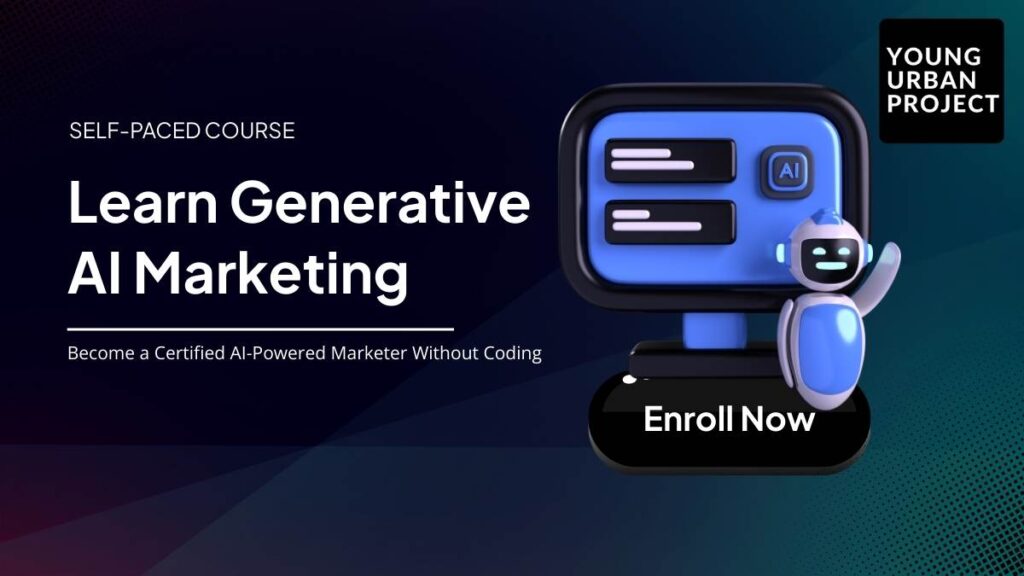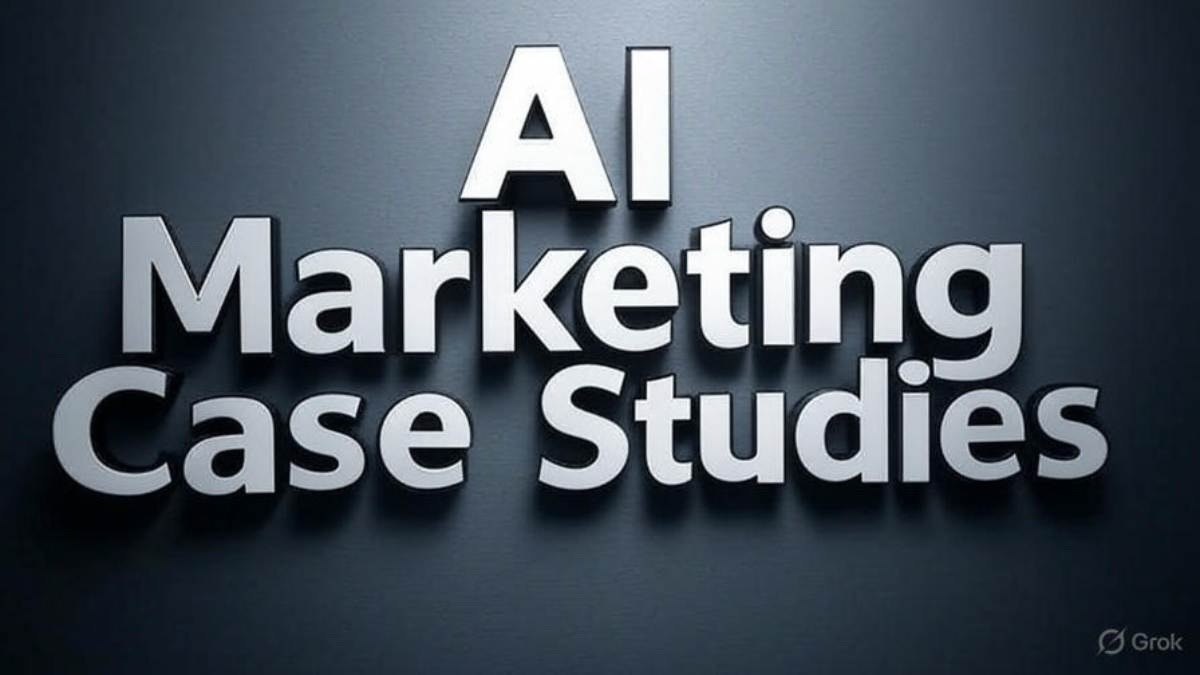It’s hard to scroll through LinkedIn or open a marketing newsletter without seeing something about AI. From bold claims to slick demos, AI is stealing the spotlight in marketing. But beyond the hype, a quiet revolution is unfolding- brands are using artificial intelligence in practical, measurable ways to transform campaigns. In this blog, we dive into real-world AI marketing case studies from Starbucks, BMW, Nutella, and more, showcasing how they leveraged AI for personalization, creativity, and efficiency. These stories prove AI isn’t just buzz – it’s delivering results that redefine what’s possible in marketing.
Table of Contents
What is AI Marketing?
You hear about AI marketing everywhere, but what is it really? Simply put, it’s using artificial intelligence to make marketing easier, more targeted, and way sharper.
Let’s make it clear.
Picture a team that never sleeps, digging into your data, studying what your audience loves, spotting what clicks, and helping you build campaigns that truly hit the mark. That’s AI – your tireless helper, no coffee breaks needed. By using reputable AI development services, you gain access to intelligent systems that optimize marketing strategies, automate decisions, and deliver real-time insights. Whether it’s personalizing user experiences or predicting customer behavior, these AI solutions work around the clock to keep your business ahead of the curve.
It’s not a futuristic robot stealing marketing jobs. Think of it as a super-quick assistant that boosts your decisions, like picking the perfect email subject line or the ad that’ll grab your audience.
At its heart, AI marketing uses data, smart formulas, and automation to:
- Guess what customers will do next
- Tailor content and deals just for them
- Handle boring, repetitive tasks
- Fine-tune campaigns on the fly
Best part? You don’t need to be a giant brand to use it. Even small teams can jump in with AI tools to stay ahead.
Also Read: Myntra Case Study
Common AI Applications in Marketing Today
If you’re using tools like ChatGPT, Canva’s Magic Design, or Meta’s ad platform, you’re already using AI, even if you didn’t realize it.
Here are some everyday ways AI is already being used in marketing:
1. Personalized Recommendations
You know how Spotify always seems to know what song you want next? Or how Netflix suggests the perfect show for your mood? That’s AI at work, using your behavior to recommend content. The same thing applies in e-commerce, where platforms show customers products they’re most likely to buy based on browsing history.
2. Email Campaign Optimization
AI tools can figure out the best time to send emails, who’s most likely to open them, and even which subject lines are likely to perform better, all by analyzing past engagement data.
Also Read: Uber Case Study
3. Chatbots and Virtual Assistants
From simple FAQ bots to smart assistants that qualify leads or help users book a demo, AI chat tools are helping businesses stay responsive without burning out their teams.
4. Ad Targeting and Creative Testing
Platforms like Facebook and Google Ads now use machine learning to decide which users should see your ad, which version of the creative works best, and where to place it, all in real-time.
5. Content Generation
AI is now helping marketers brainstorm ideas, write drafts of blog posts, suggest captions, and even create visuals. Again, it’s not about replacing the creative process, it’s about speeding it up and giving you more to work with.
6. Customer Segmentation
AI can group your audience into micro-segments based on behavior, preferences, and purchase intent. This helps you send the right message to the right person, instead of blasting everyone with the same email or ad.
Also Read: Netflix Case Study
Case Study 1: Starbucks’ Predictive Ordering & Personalization
Starbucks isn’t just brewing coffee, it’s brewing data.
The company’s AI engine, Deep Brew, helps power a hyper-personalized experience by analyzing a customer’s order history, location, time of day, and even local weather. For example, on a hot Monday morning, the app might suggest your usual iced latte. But if it’s raining on a weekend, maybe it nudges you toward a hot cappuccino instead.
How it works:
- Pulls from past purchases, location, weather, and time patterns
- Integrates with Starbucks Rewards to offer tailored promotions
- Embedded in the mobile app, loyalty system, and even voice ordering
The goal? Make the app feel like it knows you better than your barista.
Results:
- Boost in repeat orders and app usage
- More engagement from personalized offers vs generic ones
- Over 34.3M active loyalty members in the U.S. alone (Source)
It’s a smart blend of convenience and data-driven loyalty; no surprise, Starbucks is ahead of the curve.
Also Read: Starbucks Case Study
Case Study 2: Amazon’s AI Recommendation Engine
Amazon’s AI doesn’t just recommend products, it nudges behavior. Their recommendation system contributes to over 35% of total sales, making it one of the most profitable pieces of the platform. (Source)
Here’s what’s happening behind the scenes:
- Collaborative filtering: Matches your behavior with users who act like you
- Deep learning: Tracks micro-patterns, what you click, how long you hover, even device used
- Dynamic personalization: Every homepage, product list, and email is uniquely generated
If you’ve ever seen “Customers who bought this also bought…” or “Inspired by your browsing,” that’s AI at work.
It goes beyond just product pages:
- Suggests bundle deals
- Curates abandoned cart emails
- Adjusts offers based on trends and seasons
The engine gets smarter with every click. You don’t just shop on Amazon, Amazon shops with you.
By embedding AI across the customer journey, Amazon turns browsing into buying, again and again.
Also Read: Coca-Cola Case Study
Case Study 3: Sephora’s AI Beauty Advisor
Sephora figured out early that buying beauty products online isn’t always easy. Shade matching? Texture? Undertone? These things are tricky without an in-store experience.
That’s where Sephora’s AI tools step in, Virtual Artist and Color IQ. They help shoppers find the right products by blending AR with AI-powered data matching.
How it works:
- Users upload a selfie or use live camera
- The app scans facial features and skin tone
- AI recommends foundations, lipsticks, and eyeshadows tailored to each face
No more guessing between “Warm Ivory” and “Golden Beige.”
Benefits:
- Shoppers try products virtually before buying
- Reduced return rates from mismatched shades
- Increased time spent on app and higher engagement
It’s not just helpful, it’s fun. People play with looks, save favorites, and feel more confident before they purchase.
By turning smartphones into beauty counters, Sephora created an experience that’s both tech-forward and deeply personal.

Enroll Now: Advanced Generative AI for Marketing
Case Study 4: BMW’s Generative AI Ad Campaign
BMW took a bold leap into AI-powered creativity, and it paid off.
To launch a new campaign across multiple markets, BMW used generative AI tools to produce localized ad content. This included visuals, headlines, and even social media captions tailored for different countries, languages, and cultural nuances.
What they did:
- Generated visuals based on AI prompts aligned with their luxury brand tone
- Created dynamic headlines optimized for local languages
- Used AI tools like DALL·E and GPT-based copywriters for fast iterations
This wasn’t about replacing creatives, it was about scaling them.
Results:
- Faster turnaround time across regions
- Significant cost savings on design and localization
- Boost in reach and engagement due to more relevant, tailored content
BMW proved that creativity and automation don’t have to clash. In fact, when used thoughtfully, AI can give global brands a way to stay locally relevant without sacrificing quality, or blowing up the budget.
Also Read: Zomato Case Study
Case Study 5: Nutella’s 7 Million AI-Generated Jar Designs
Nutella pulled off something wildly unexpected, they turned every jar into a unique work of art. Literally.
In a campaign called “Nutella Unica,” the brand used an AI algorithm to generate 7 million one-of-a-kind packaging designs. No two jars looked the same. (Source)
How it worked:
- Nutella fed patterns, shapes, and colors into a generative design algorithm
- AI randomly combined elements within brand-safe guidelines
- The system ensured every label was distinct yet instantly recognizable
The result? Supermarket shelves turned into mini art galleries.
Why it worked:
- Made the jars collectible, people actually hunted for their favorite
- Repositioned Nutella from “just a breakfast spread” to something more playful and creative
- Encouraged user-generated content, with fans sharing photos of their unique jars
Sales spiked during the campaign. More importantly, brand love went up, Nutella became the kind of brand people wanted to talk about again.
It was a simple twist using AI, but a powerful one.
Also Read: McDonald’s Case Study
Case Study 6: Volkswagen’s Predictive AI for Consumer Behavior
Volkswagen used AI not just to advertise, but to figure out who’s actually ready to buy.
They built a predictive model to identify high-intent consumers based on behavior across platforms. Instead of blasting generic ads to everyone, they used AI to focus spend where it mattered most.
What the AI analyzed:
- Browsing patterns across websites and product pages
- Search intent (keywords, recency, frequency)
- Past interactions with VW ads or dealership visits
- Time spent on vehicle configuration tools
Based on these signals, AI scored each user’s likelihood to convert. Then it pushed ads specifically to the highest-potential leads.
Impact:
- Better use of media budget
- Lower cost per lead
- Higher showroom visits and test drives
- Improved conversion rates across digital campaigns
This wasn’t flashy or gimmicky. It was about precision, something that’s hard to do manually at scale.
Volkswagen showed how AI can quietly power smarter marketing, just by being more selective and data-driven.
Also Read: Amazon Case Study
Case Study 7: Heinz’s “A.I. Ketchup” Campaign
Heinz decided to test a fun question: If you asked AI to draw “ketchup,” what would it come up with?
In their clever campaign, they fed prompts like “ketchup bottle,” “ketchup splatter,” and “ketchup logo” into an image-generating AI. The results? Almost every image, whether realistic or surreal, resembled a Heinz bottle.
That was the moment. Without saying it directly, Heinz proved that their bottle is what ketchup looks like, even in the eyes of AI.
Why it worked:
- Played off curiosity and humor around generative AI
- Created content that felt modern, weird, and very shareable
- Reinforced Heinz’s iconic branding without heavy-handed messaging
The campaign sparked conversation online, gained media coverage, and helped Heinz connect with younger, tech-savvy audiences, all while keeping its brand voice intact.
More than anything, it showed how AI can amplify creativity, not replace it.
This wasn’t about automation. It was about brand confidence, and it landed perfectly.
Also Read: Amul Case Study
Key Takeaways from These AI Marketing Case Studies
Looking at all these real-world examples, one thing’s clear: AI in marketing is already delivering results.
It’s not about robots taking over or creativity getting watered down, it’s about being smarter, faster, and more relevant.
Here are a few big lessons that stand out:
- AI supercharges personalization
Whether it’s Starbucks recommending your next drink or Amazon suggesting products, the more personal the message, the better it performs. - Creativity + AI = Serious scale
Brands like BMW and Heinz used AI with their creative teams, not instead of them, and ended up doing more, faster, without losing quality. - Good data = Good AI
Every success story here had one thing in common: clean, well-structured data. That’s what makes the tools work. - AI is an assistant, not a replacement
The best results came from brands who used AI to remove the busywork and elevate human creativity.
Also Read: Uniqlo Case Study
Conclusion: Where AI in Marketing Is Headed
At the end of the day, AI isn’t just a shiny new tool. It’s a mindset shift.
The brands that win in this space aren’t the ones who just “experiment” with AI, they’re the ones that embed it strategically. They treat AI as a partner, not a one-off campaign gimmick.
If you’re a marketer wondering where to start, the key is to start small, start smart. Pick one area (like content creation, email automation, or audience targeting), try out an AI-powered tool, measure the impact, and then build from there.
The future of marketing? It’s not AI vs. human. It’s AI with human. The marketers who embrace that hybrid mindset are going to outpace everyone else.
FAQs: AI Marketing Case Studies
1. How do companies choose the right AI tools for marketing?
They start by looking at what problems they want to solve, like faster content, better targeting, or automation. Then they check if the tool fits with their budget, existing software, how easy it is to use, and whether it works with their data.
2. Can small businesses also use AI in marketing?
Yes, totally. There are affordable AI tools for small teams, like AI chatbots, email automation, ad copy generators, and design tools. You don’t need a tech team. Most of these tools are plug-and-play and super beginner-friendly.
3. Is AI replacing marketers?
Nope. AI helps with the boring, repetitive stuff, like sorting data or writing first drafts. But big ideas, creativity, strategy, and brand voice still need a human touch. Think of AI as a helpful sidekick, not a replacement.
4. What are the risks of using AI in marketing?
There are a few. Bad data can lead to weird results. AI can sometimes show bias. If you rely too much on it, your brand might feel cold or robotic. Also, privacy laws matter, you need to be careful with user data.
5. How do you measure the ROI of AI marketing efforts?
You can track how much money or time it saves. Look at conversion rates, sales lifts, ad performance, or how much faster you can create content. Compare results before and after using the tool, that usually shows the real value.
6. Which industries benefit most from AI in marketing?
E-commerce, beauty, auto, retail, tech, and media companies are seeing big wins. Basically, any industry with lots of customer data or content can use AI to personalize, automate, and work smarter, not harder.

